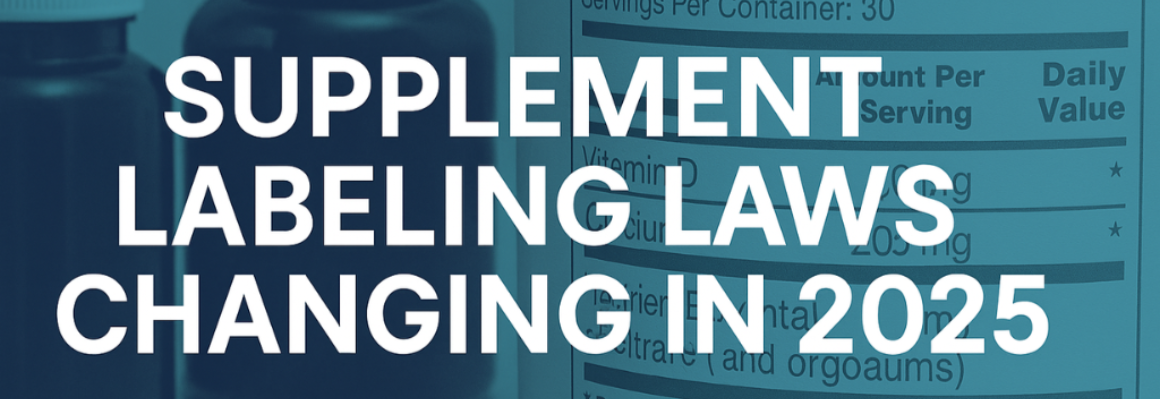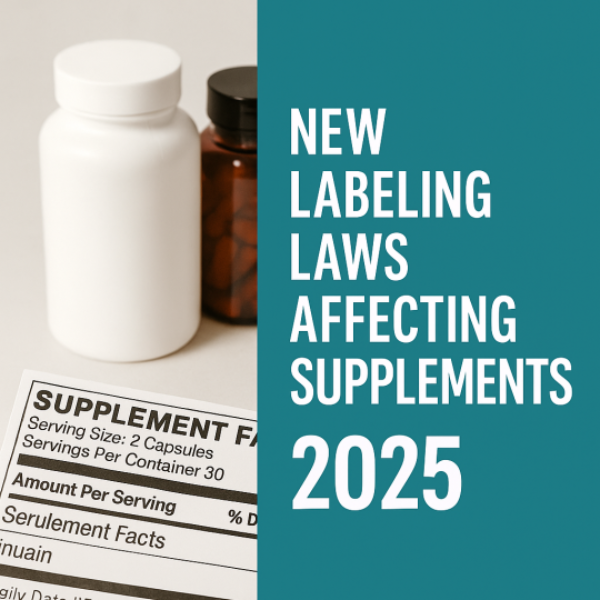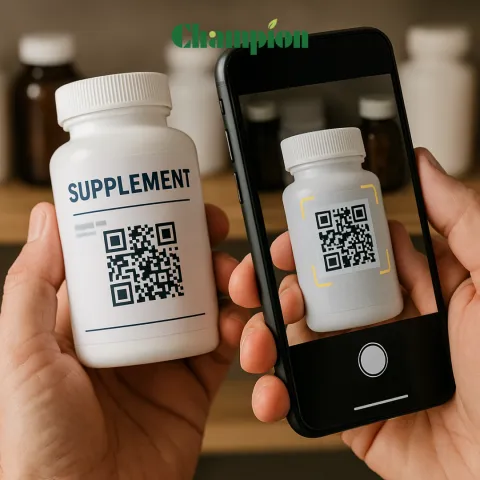Blog
08.Oct.2025
New Labeling Laws Affecting Supplements in Key Markets

Introduction
Supplement labeling is getting a regulatory overhaul worldwide. As consumer demand for transparency and scientific claims grows, authorities in the US, EU, and throughout Asia-Pacific are rolling out law changes that impact language, layout, ingredient disclosure, and what brands can—and cannot—claim. In 2025, mastering global supplement labeling laws isn’t just about avoiding penalties; it’s essential for market access, retailer approval, and consumer trust.United States: FDA’s New Front-of-Package and Claim Rules
2025 Regulatory Shifts
- Front-of-Package (FOP) Nutrition Labeling: The FDA is proposing a mandatory FOP label (“Nutrition Info box”) summarizing sodium, added sugar, and saturated fat as Low/Med/High for fast consumer comparison. Although dietary supplements are exempt as of 2025, the FOP trend signals tighter consumer labeling expectations overall.
- Updated “Healthy” Claims: The FDA has finalized stricter criteria for use of “healthy” on supplements, now tied to food group equivalents and stricter nutrient thresholds. Brands must ensure product composition and claims meet the new standards by 2028.
- Ingredient & Allergen Disclosure: Emphasis on full ingredient lists, including sources and allergens, and explicit warning/caution language.
- Enforcement Spike: FDA’s new Human Foods Program involves heightened ingredient pre-clearance, updated label guidance, and stronger post-market surveillance—including warning letters and recalls for ambiguous claims or undisclosed ingredients.
European Union: Harmonization and Claim Crackdown
- Label Harmonization: Supplements in the EU must meet Regulation (EU) No. 1169/2011 (general food info) and Directive 2002/46/EC (supplement presentation), demanding ingredient, nutrient, origin, usage, and warning details in legible local language.
- Health Claims Authority: All health or nutrition claims must be EU Register-approved (Regulation EC No. 1924/2006); otherwise, they are banned. “Clinically proven” and “natural” claims must match approved scientific data and be non-misleading.
- Country-Level Nuances: Despite efforts at harmonization, Germany, France, Italy, and Spain apply additional requirements, especially around botanicals, maximum/minimum dosages, and dosage form warnings.
- Novel Foods/Ingredients: Any non-traditional ingredient needs EFSA pre-market authorization, documented on labels with source and function. Traceability and batch tracking are now more strictly enforced for imported products.
Asia-Pacific: Regulations and Documentation on the Rise
- China: 2025 amendments focus on clear, accurate, and truthful labeling, with specific authorized function claims, ingredient source disclosure, and mandatory pre-market documentation for new actives.
- Indonesia: BPOM introduced new guidelines in 2025 addressing supplement labeling structure, stability testing, expiration dating, and composition/claim clarity.
- ASEAN Regional Trends: Efforts toward standardization continue, but most countries retain their own registration and ingredient rules. Halal certification is mandatory in Muslim-majority states—requiring clear Halal logos and compliant ingredient tracking.
- South Korea/Japan: Supplements treated as quasi-pharmaceuticals require explicit function/ingredient disclosure, sometimes including proof of clinical evidence or a notation if non-EFSA/US-FDA documented claims are used.
Common Themes in 2025 Supplement Labeling Laws
- Clear identification and standard naming of every ingredient, including source (plant/animal/mineral).
- Full supplement facts panel: serving size, per-dose content, total content per package, usage instructions.
- Allergen and cross-contamination warnings.
- Expiry date (not just manufacture date), especially for probiotics, enzymes, or prebiotics, where potency may degrade.
- Country of origin, business operator contact, and batch/trace codes for recalls.
- Precautionary warnings (“not for use under age 18,” pregnancy, pre-existing conditions).
- Specific restrictive language for health or “functional” claims—strict borders between “supports” language and disease prevention/cure claims.
Best Practices for Supplement Label Compliance
- Know the Market: Start market registration and formulation projects with legal and regulatory reviews for every target country/region.
- Audit Every SKU: Don’t assume approval in one country (“harmonization”) means compliance elsewhere. Customize ingredient disclosures, warning language, and claims.
- Work With Legal Experts: Engage specialists who track ongoing global regulatory updates in supplements for periodic reviews.
- Keep Digital Records: Archive proof of registration, ingredient COAs, and label versions to speed re-registration and minimize risk during audits or retailer onboarding.
- Anticipate Reformulation: Some jurisdictions are pushing further restrictions on sweeteners, botanicals, or “novel foods”; maintain flexibility in NPD roadmaps.
Labeling Watch: Real-World Brand Applications
- US/EU: Brands reformulated or relabeled to comply with the “healthy” rule found 35% faster approvals in retailer onboarding and fewer warning letters.
- Asia: Adding Halal, vegan, and eco-labels increased trust among Muslim and Gen Z buyers, directly lifting conversion rates both online and in retail.
- EU Imports: A large French distributor was denied import due to missing allergen info in local language and lack of authorized health claim confirmation, despite EU-wide approval.
Frequently Asked Questions
Q: What is the biggest labeling mistake brands make in 2025?A: Not localizing claims, allergen, or ingredient info to specific market regulations—often resulting in denied imports, recalls, or warnings.
Q: Do supplements need a supplement facts panel in every market?
A: US requires a Supplement Facts panel; the EU and Asia require similar nutrition/content panels but with varying format and required details.
Q: Are structure/function claims allowed everywhere?
A: Not everywhere. US/Asia allow if supported by science and disclaimer is added. EU allows only “approved” health claims from the central register; others are not permitted.
Q: How can brands monitor ongoing changes?
A: Join regional industry groups, engage legal consultants, and subscribe to regulatory news feeds to catch updates early.
Conclusion
Navigating supplement labeling laws in 2025 demands vigilance, localization, and continuous learning. Brands that stay nimble and proactive—leveraging expert input, tech-aided version control, and regulatory watch—are best positioned for safe, scalable growth.
Need regulatory support?
Contact our compliance specialists for a documentation health check, region-ready label review, and an update on the latest country-specific laws.



















